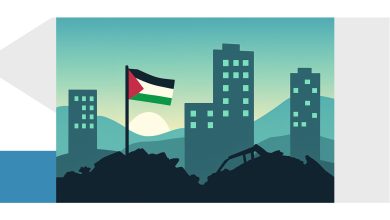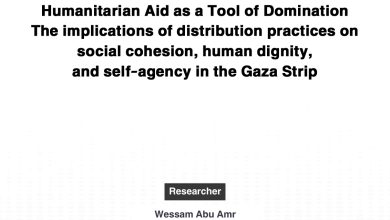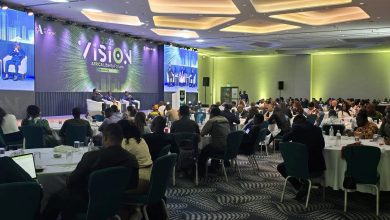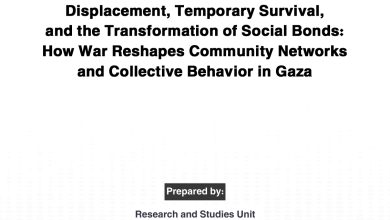Rebuilding Gaza: Considerations for a Habitable Futusre


Omar Shaban
Introduction
Israel’s assault on Gaza has raged on for over seven months, with no end yet in sight. Undoubtedly, the genocide has had a global impact—from Houthi mobilization in the Red Sea, to rising tensions between Israel and Iran, to mass student mobilization across the US and Europe. Still, while the world’s attention may be on Palestine more so than in generations past, it comes at a shattering cost. Indeed, the sheer numbers of fatalities (estimated now at over 35,000), those displaced, and homes destroyed can’t do justice to the level of devastation that Gaza has shouldered since October, 2023.
Even so, it remains necessary for Palestinians to lead the conversation on what comes after Israel’s genocide. To opt out of these discussions is to leave our collective future in the hands of the very people who have sought for decades to erase us. Accordingly, this commentary offers an entry point to a Palestinian dialogue on what may follow after a ceasefire is reached. It does so by delving into the current non-Palestinian “day after” discourse, then by identifying the ways in which today’s reconstruction effort is distinct from those of the past, and finally by putting forth a possible approach to begin to embark on such a project.
Palestinian Exclusion in the “Day After” Discourse
Since the start of Israel’s genocidal assault on Gaza, countless debates, briefings, and think pieces have put forth various proposals for what the day after may look like. The vast majority of these discussions have, at best, featured some tokenistic Palestinian participation. More commonly, they have taken place without the inclusion of Palestinians altogether.
For example, in an opinion piece for the Foreign Policy Research Institute, Leon Hadar calls for rethinking Palestinian statehood as a long-term goal rather than an immediate policy proposal, instead suggesting that the deployment of NATO forces in Gaza or continued Israeli military occupation remain logical options in the short term. In another instance, a joint project between the Jewish Institute for National Security of America (JINSA) and The Vandenberg Coalition advocates for the creation of the International Trust for Gaza Relief and Reconstruction. In its proposal, the eight-member project committee describes the trust as a “super-NGO” to be steered by Saudi Arabia, Egypt, and the United Arab Emirates. Chatham House also released a “day after” piece, authored by Sanlam Vakil and Neil Quilliam, which likewise implores Gulf states to take a more proactive role in post-ceasefire planning as well as support for Palestinian statehood efforts.
Importantly, none of these proposals centered Palestinian voices—neither as authors nor as expert sources. This exclusionary analysis that favors non-Palestinian insights over Palestinian expertise and lived experience is not unusual. Rather, it is part of a long-held trend to preclude Palestinian autonomy and self-determination in the context of policy planning.
The plethora of “day after” analysis comes as it is made increasingly clear that the Israeli regime embarked on its assault on Gaza with the singular goal of eradicating Hamas, and without any plan for what comes next. The past several months, in particular, suggest that even this objective is in flux for Israel, as its military continues to carry out widespread indiscriminate massacres and destruction across much of Gaza.
While Netanyahu has ruled out the possibility of the Palestinian Authority (PA) governing Gaza once a ceasefire is reached, Biden has advocated for that very option. In a move to regain some legitimacy among global partners, PA President Mahmoud Abbas recently put together a new technocratic government. Still, it remains to be seen how the “revitalized” PA will be received by Israeli policymakers—let alone by the Palestinian people, who have yet to have elections since 2006.
Obstacles to Reconstruction
Gaza has already faced the devastating project of reconstruction on several occasions, and many aspects of the previous initiatives failed completely. Still, the current context presents even greater challenges than before. Below are merely a few of the multitude of considerations that must be made when accounting for what it will take to rebuild Gaza:
- Following Israel’s 2014 assault, an estimated 96,000 homes were either damaged or destroyed, and rebuilding was predicted to cost between $4-6 billion over the course of 20 years. Conversely, between October, 2023, and January, 2024, Israel had already destroyed or damaged over 335,000 housing units—more than 60% of all residences in Gaza. As of February, 2024, cost estimates for reconstruction were around $20 billion.
- In 2014, some 600,000 Palestinians sought refuge in UNRWA schools. Most were able to return to their homes within several weeks following the ceasefire, while schooling was delayed for one to two months. Today, when well over half of Palestinians in Gaza have no homes to return to, and where over 300 schools have been destroyed, the impact is far more drastic. The majority of children are likely to fall at least a year behind in schooling.
- It took 18 months to clear the majority of 2 million tons of rubble from Gaza following the 2014 assault. According to Pehr Lodhammar, former United Nations Mine Action Service Chief for Iraq, the current genocide has already generated over 37 million tons of rubble. How long will it take to clear this level of destruction? Lodhammar estimates 14 years using 100 trucks. Who will provide the necessary resources and equipment to do so? Where will it go? And what of the unexploded weapons buried within? These are only a few of the questions that need to be addressed—and they must be addressed with urgency, as Palestinians cannot safely return to their lands until these remnants are cleared.
- Over 70% of Gaza’s hospitals have been entirely destroyed; the 10 that remain are only partially functioning. Rebuilding and re-equipping Gaza’s medical facilities is among the most urgent needs. This is in addition to reconstructing the water, sanitation, sewage, and basic road systems—all of which are fundamental to ensuring that people can return.
- Finally, there’s the agricultural sector. Much of the land that was used for food production has either been destroyed or repurposed to house those who have been displaced from other regions in Gaza. Such is the case for Al-Mawasi and other villages in the Khan Yunis Governorate. According to a February, 2024, report by the Food and Agriculture Organization, nearly half of all cropland in Gaza has been damaged. As a result, food insecurity will likely remain a very real problem for years to come.
A Path Toward Agency and Hope
To create a viable path for return and resurgence of life in Gaza, a number of these urgent needs must be addressed simultaneously from the start.
One approach to rebuilding may be to focus on one collection of neighborhoods at a time. If we are able to bring in the necessary resources to revitalize ten neighborhoods, for example, major progress could be made on them within a few months. This method could include identifying two neighborhoods from each of the five governorates—one city and one refugee camp in each—to initially focus on. Each of these neighborhoods may be assigned 10-20 trucks and other required equipment to remove the rubble and begin reconstruction.
In addition to addressing the most essential areas of livelihood in each of these neighborhoods—such as infrastructure, health, and food—the production and education sectors must also take precedence. Rebuilding Gaza’s productive sector, such as agriculture and export capabilities, will ensure that Gaza breaks out of the cycle of humanitarian dependency as swiftly as possible. Likewise, rapid investment in the rebuilding of schools and universities is critical to the revitalization of Palestinian civil society and the preservation of Palestinian knowledge and memory.
Throughout this process, it is vital that the residents of these communities be proactively engaged—both in decision-making as well as in implementation. Doing so will help to entrench Palestinian ownership as well as safeguard job opportunities for those most directly impacted by the genocide. These spaces for meaningful participation—whether through strategic leadership, employment, or volunteerism—will help to instill agency among Palestinians in Gaza. In taking such an approach, Palestinians will also see an example of what the future will look like for the rest of Gaza—and this can create some hope in the community. It is impossible to overstate the value of hope in these times, when so many Palestinians have lost everything. Through an incremental neighborhood strategy, those in Gaza can start to envision a viable future for the whole of Gaza. The risk of an alternative plan, by trying to resurrect basic needs for all of Gaza at once, is that the time required to rebuild some semblance of normal life may feel so out of reach that collective hope can easily dwindle.
Crucially, imparting a sense of hope will also help to expedite the process of return for those who have fled Gaza. Tens of thousands of Palestinians have left since October, 2023, many of whom remain in Egypt. While some may choose to stay outside of Gaza, many long to return to their homeland as soon as possible. For this to happen—and in order to prevent further mass exodus—possibilities for a viable future must start to take shape.
So who will lead this effort? One solution is to establish a Palestinian national committee for reconstruction. The committee may be composed of experts from the private sector and civil society, as well as diverse political representation. One of the major contributing reasons for the failure of the previous Gaza Reconstruction Mechanism (GRM), developed after the 2014 assault, is that it lacked Palestinian ownership and prioritized the interests of third-state actors as well as Israel. An independent Palestinian steering committee is thus a prerequisite to avoid repeating the mistakes of the past.
Undoubtedly, Gaza will still need the support of the international community in order to rebuild, no matter the approach taken. But critically, reconstruction must be a Palestinian-owned process. International support is not the same as international control. Palestinians have the skills and expertise needed; what we lack at this moment are the funds, equipment, access, and protection required to embark on this process. The Palestinian diaspora should also be involved in this effort, as many possess key technical knowledge and resources needed to mobilize and invest in Gaza’s future.
Of course, the question remains: who will fund reconstruction? It’s worth recalling that many of the pledges to the GRM made at the 2014 Cairo conference were never dispersed. Indeed, over two years after Israel’s brutal assault, nearly half of the pledged funds had yet to be fulfilled. The vast majority—nearly 90%—of unmet pledges came from the Gulf. As a result, vital infrastructure was never rebuilt. Moreover, the international community is growing increasingly pessimistic about the impact of their investments, when so many of the projects they fund are repeatedly destroyed by Israeli bombardments. This in no way absolves third states from their obligation to support reconstruction in Gaza, but rather underscores the need for such a process to be coupled with a concerted push for a political solution—one that honors Palestinian return and self-determination as well as protects Palestinians from the possibility of a future genocide.
Beyond Gaza’s physical reconstruction, new efforts must also be taken to rebuild the Palestinian political system. While those in Gaza cannot participate in a political process at this current moment, a roadmap that clarifies future political directions is still needed. This should include steps to end the political divide, beginning with the promise of Palestinian elections within a defined timespan. Palestinians in Gaza are clear that the political fragmentation between Fatah and Hamas since 2007 has been tremendously detrimental to the wider struggle for liberation. Political reconciliation is imperative to a lasting future for Palestinians, as well as to broader regional stability. While the Palestinian Authority is in desperate need of reconstruction itself, what is evident is that the ongoing political fragmentation is unsustainable and that those in Gaza and the West Bank, including East Jerusalem, must be united under the same leadership.




